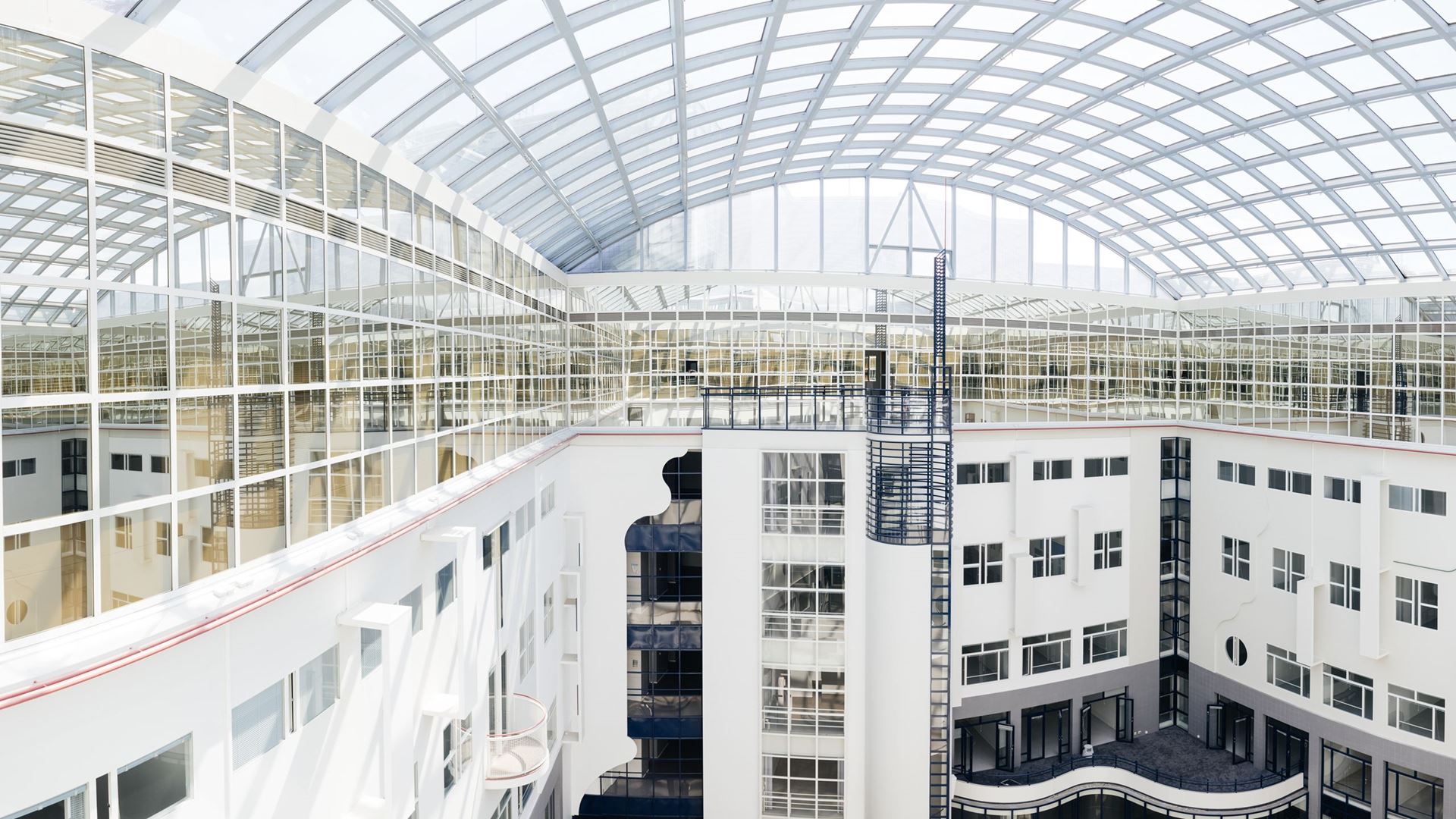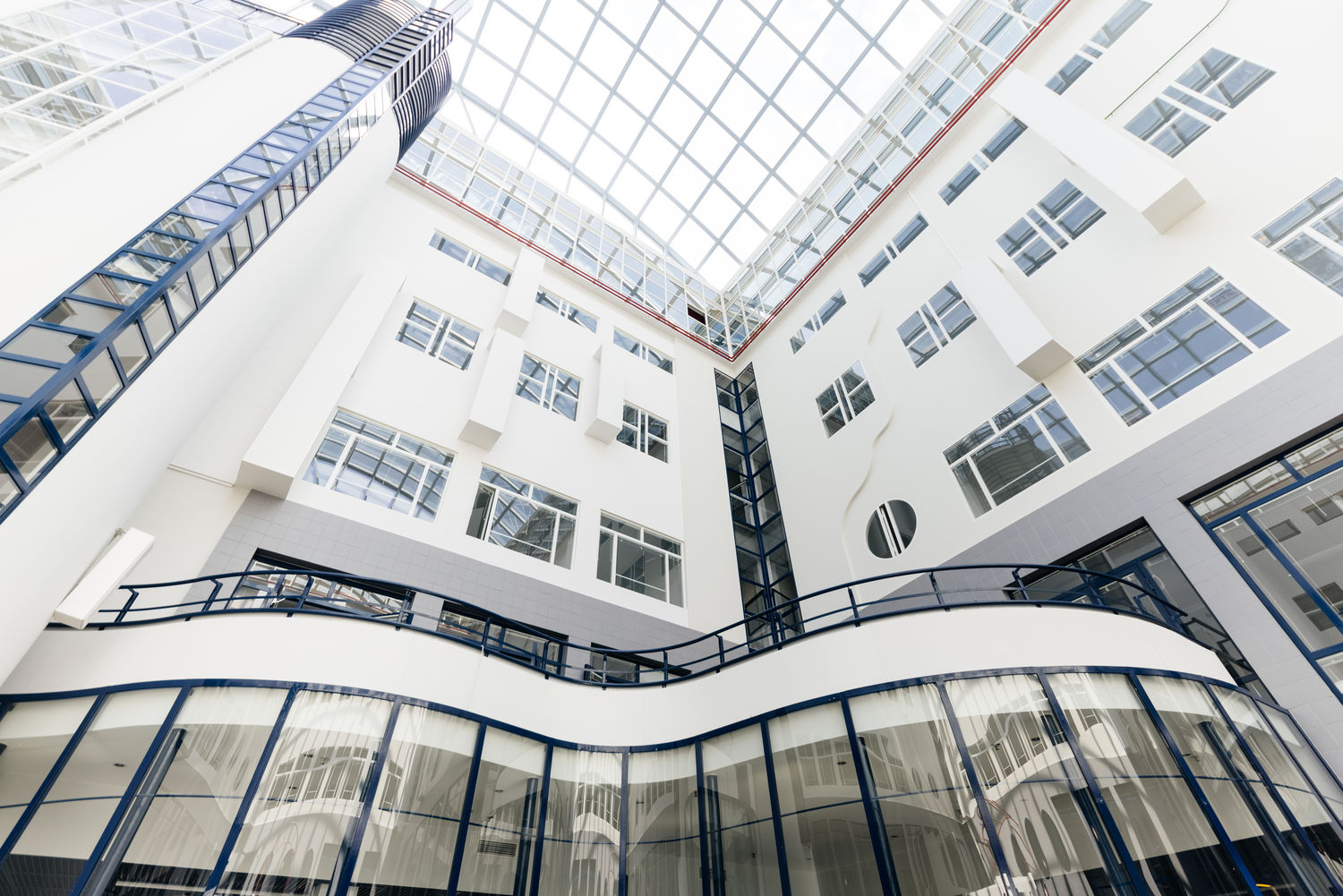Sustainable data centers as a service
- City
- Construction
- Premises
- Sustainability
- 9/19/2023
Maistraatinportti – responsibly ready for 2050
Maistraatinportti in Länsi-Pasila is an architectural gem of the 1980s. The renovation will be completed in September and the journey of Maistraatinportti will continue as a state-of-the-art office building, where history, architecture and materials have been preserved.

The building was completed in 1987 as an inspiring working environment for a newspaper company. After renovation, it continues to live on as a multi-user office building. Architect Ilmo Valjakka's distinctive original architecture remains intact, but the space has been renovated to meet the demands of today's hybrid workplace.
The renovation of this gem of post-modern architecture is also a real environmental act.
"The carbon footprint of the construction phase of the renovation is estimated to be around 75% lower compared to a new building," says Kimmo Assmuth, Project Manager of Maistratinportti.
Certificates and ratings make everyone work smarter
We walk up two flights of the original 1980s stone staircase. Most of the surfaces have been replaced, but the basic structures have been preserved.
"The recycling rate on site is around 83%," says the Project Manager.
Behind the office-floor waste-parking sign are eight different recycling bins, from metals to PVC plastic. A top-notch clean site shows that environmental issues are taken seriously here.
The Project Manager's own desk in the site office is adorned with a bundle of different reports: a LEED environmental pre-certification report, a review of compliance with the Paris climate target using the Carbon Risk Real Estate Monitor tool, an EU taxonomy report, a pre-certification report for WELL certification for the well-being of building users.
Various certifications are a way of verifying the responsibility of construction. They increase transparency and comparability of projects.
"Today, large property owners have very ambitious environmental targets for their property portfolios. Today's tenants, the users of the property, also want more and more sustainable premises. We can and want to meet this need," says Kimmo Assmuth.
LEED is the most widely used global environmental rating system for buildings. Its strength is its uniform criteria and comparability worldwide. LEED Gold environmental certification is being sought for Maistraatinportti. The office building, located next to Pasila station and the Tripla shopping centre, scores high for its location, and during the design phase, for example, the building's future energy and water consumption has been reduced through a number of solutions to meet LEED criteria.
The EU taxonomy is a common EU classification system that aims to guide funding and investment towards green and environmentally sustainable objectives such as climate change mitigation or the circular economy. From that perspective, the project is well placed as it already meets the requirements of the taxonomy, although some of the future EU requirements for the construction sector are still to be specified. For example, the Maistraatinportti site clearly exceeds the EU's 70% recycling rate target.

Carbon emissions simply have to be reduced
YIT is the first Finnish construction company to commit to the Science Based Target (SBTi) initiative and have its emission reduction targets approved by SBTi. YIT aims to limit global warming to 1.5 degrees Celsius in line with the Paris Climate Agreement through its own emission targets, which will affect all projects, including the Maistraatinportti. Kimmo Assmuth presents the specific emissions after the renovation of the site, which are significantly lower than before the renovation. On the positive side, as Finland's electricity and heat production becomes greener, emissions from buildings are also falling year on year. Based on current requirements and calculations, the renovation of the Maistraatinportti will enable the project to meet the Paris climate targets until 2047.
However, not all solutions are suitable for all sites. For example, the designers considered a geothermal heating system for Maistraatinportti, but the plot did not allow for it. However, improving energy efficiency is an ongoing process that will continue for decades after the renovation.
"All energy efficiency investments also have a carbon footprint. In the future, we may achieve greater carbon benefits with smaller investments, for example by improving the efficiency of heat pumps and solar panels," says Kimmo Assmuth.
On the construction site, sustainability requirements are reflected in many aspects. During the renovation phase, the biggest sources of emissions are concrete casting and other construction materials used on site. For example, low-carbon concrete is used on the site, with carbon emissions 15% lower than base concrete. The construction site's steel beams also have lower emissions than usual.
Low emissions have been taken into account in building materials, insulation, heating and life-cycle maintenance. Smart building technologies have enabled the use of remote cooling, energy-saving lighting control and occupancy sensors that control ventilation.
"Sustainability is about choices and actions big and small, but they need to be made all the time and at all stages of the building process. From land acquisition to design and construction, operation and maintenance," says Kimmo Assmuth.
Respecting history
The renovation of the Maistraatinportti opens up an understanding of what renovation is at its best from a sustainability perspective.
Kimmo Assmuth explains that the finest office architecture of its time was well suited to the office building requirements of the 2030s. In the aftermath of the COVID-19 pandemic, offices have become meeting places where ideas are generated and decisions are made face to face.
At the heart of the building is a high atrium.
"It's an invitation to get together. The conditions for working together are good," says Kimmo Assmuth.
This was also the aim of the building's designer. A building history survey carried out before the renovation reveals the history of the building: “Yhtyneet Kuvalehdet publishing house felt that it was not in the building's nature to shackle the architect's creativity – you can't shackle freedom of speech either. The company's aim was to make the building a place where different ways of working could be reconciled, since in the press industry, ensuring conditions for teamwork was a key value."
Marianna Heikinheimo, the author of the report from the architectural firm Ark-Byroo, points out that responsible construction is not just about environmental responsibility. The renovation of an old office building is, in architect Heikinheimo's opinion, a fine example of social responsibility. "This is a particularly stunning building, one of the key works of architecture of the 1980s."
With such a young building stock, it is not always possible to see what is valuable and what is not.
"Preserving the cultural environment allows people to identify with places in the city, and make them part of their own story."
Memories have been made, for example, of the opening of the newspaper building in September 1987. The main stage for 11 different events during the opening week was the atrium courtyard, where the nation's leaders, including President Mauno Koivisto and others, gathered.
Heikinheimo believes that in the future, the focus of construction will shift more and more towards renovation projects. In the past, new buildings have automatically been considered more energy-efficient than renovating old ones. However, new buildings generate a higher carbon emission peak during the construction phase than renovations.
"In the future, we will produce energy more cleanly than today. In the long term, the emissions from renovated buildings will then also be lower than those from new construction."
Sustainability issues have been high on the Project Manager's priority list for the Maistraatinportti.
"Although the bar has been raised many times during the project, we have always gone beyond it," says Kimmo Assmuth.



